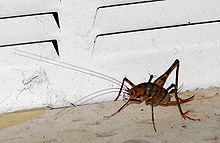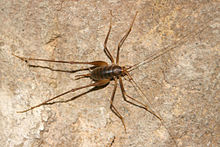- Rhaphidophoridae
-
Rhaphidophoridae 
Scientific classification 
Kingdom: Animalia Phylum: Arthropoda Class: Insecta Order: Orthoptera Superfamily: Rhaphidophoroidea
C. Thomas, 1872Family: Rhaphidophoridae
Brunner von Wattenwyl, 1888Subfamilies and genera See text
The orthopteran family Rhaphidophoridae includes the cave wetas, cave crickets, camelback crickets, camel crickets, spider crickets (sometimes shortened to "sprickets" or "criders"[citation needed]) and sand treaders, of the suborder Ensifera; in some regions, such as Missouri and Virginia, these crickets are referred to as "Cricket Spiders"[citation needed]. Those occurring in New Zealand, Australia, and Tasmania are typically referred to as wetas. Most are found in association with caves, animal burrows, cellars, under stones, in wood or in similar environments. They are characterized in part by their long antennae and legs. They may be found on all continents and many continental islands, though Africa has but one species and that is confined to the southern Cape region. The well-known field crickets are from a different superfamily (Grylloidea) and only look vaguely similar, while members of the family Tettigoniidae may look superficially similar in body form.
Description
Cave crickets have very large hind legs with "drumstick-shaped" femora, and long, slender antennae. They are brownish in color and rather humpbacked in appearance, always wingless, and up to two inches/5 cm long in body and 10 cm (4 inches) for the legs. The bodies of baby crickets may appear translucent. As the name implies, cave crickets are commonly found in caves. However, most species live in other cool, damp situations such as in wells, rotten logs, stumps and hollow trees, and under damp leaves, stones, boards, and logs. Occasionally, they prove to be a nuisance in the basements of homes in suburban areas. Some reach into alpine areas and live close to permanent ice — the Mount Cook "flea" and its relatives in New Zealand.
Their distinctive limbs and antennae serve a double purpose. Typically living in a lightless environment, or active at night, they rely heavily on their sense of touch, which is limited by reach. While they have been known to take up residence in the basements of buildings, many cave crickets live out their entire lives deep inside actual caves. In those habitats they sometimes face long spans of time with insufficient access to nutrients. To avoid starvation, they have been known to devour their own extremities, even though they cannot regenerate limbs. Given their limited vision, cave crickets will often jump towards any perceived threat in an attempt to frighten it away. Although they look intimidating, they are completely harmless.[1]
Cave and camel crickets are of little economic importance except as a nuisance in buildings and homes, especially basements. They are usually "accidental invaders" that wander in by mistake from adjacent areas. They generally reproduce indoors, especially in situations that provide continuous dark, moist conditions, such as a basement shower or laundry area, as well as organic debris to serve as food.
The group known as "sand treaders" are restricted to sand dunes, however, and are adapted to live in this environment. They are active only at night, and spend the day burrowed into the sand, to minimize water loss. In the large sand-dunes of California and Utah they serve as food for scorpions.
Subfamilies and genera
- Subfamily Aemodogryllinae — cave crickets: Asia (Korea, Indochina, Russia, China)
- Diestrammena
- Eutachycines
- Microtachycines
- Paradiestrammena
- Paratachycines
- Adiestramima Gorochov, 1998
- Diestramima Storozhenko, 1990
- Gigantettix Gorochov, 1998
- Megadiestramima Storozhenko & Gorochov, 1992
- Tamdaotettix Gorochov, 1998
- Atachycines Furukawa, 1933
- Neotachycines Sugimoto & Ichikawa, 2003
- Subfamily Ceuthophilinae — cave crickets, camel crickets & sand treaders: United States
- Ammobaenetes Hubbell, 1936
- Ceuthophilus Scudder, 1863
- Daihinia Haldeman, 1850
- Daihinibaenetes Tinkham, 1962
- Daihiniella Hubbell, 1936
- Daihiniodes Hebard, 1929
- Farallonophilus Rentz, 1972
- Macrobaenetes Tinkham, 1962
- Phrixocnemis Scudder, 1894
- Pristoceuthophilus Rehn, 1903
- Rhachocnemis Caudell, 1916
- Salishella Hebard, 1939
- Styracosceles Hubbell, 1936
- Typhloceuthophilus Hubbell, 1940
- Udeopsylla Scudder, 1863
- Utabaenetes Tinkham, 1970
- Subfamily Dolichopodainae — cave crickets: Mediterranean
- Dolichopoda
- Subfamily Hadenoecinae — cave crickets: United States
- Euhadenoecus[2] Hubbell, 1978
- Hadenoecus Scudder, 1863
- Subfamily Macropathinae — cave wetas: Australia, Chile, New Zealand
- Dendroplectron
- Gymnoplectron
- Insulanoplectron
- Ischyroplectron
- Isoplectron
- Macropathus
- Neonetus
- Novoplectron
- Pachyrhamma Brunner von Wattenwyl, 1888
- Pallidoplectron
- Paraneonetus
- Petrotettix
- Pharmacus
- Pleioplectron
- Setascutum
- Talitropsis
- Turbottoplectron
- Weta
- Subfamily † Protroglophilinae
- † Protroglophilus
- Subfamily Rhaphidophorinae — camel crickets: United States
- Gammarotettix Brunner, 1888
- Subfamily Troglophilinae — cave crickets: Mediterranean
- Troglophilus
- Subfamily Tropidischiinae — camel crickets: Canada
- Tropidischia Scudder, 1869
An as-yet-unnamed genus was discovered within a cave in Grand Canyon Parashant National Monument, on the Utah/Arizona border, in 2005. Its most distinctive characteristic is that it has functional grasping cerci on its posterior.[3]
References
Categories:- Orthoptera
- Cave organisms
- Subfamily Aemodogryllinae — cave crickets: Asia (Korea, Indochina, Russia, China)
Wikimedia Foundation. 2010.



